VTech Genius IQ 128
The Genius IQ 128 by VTech was released in 1996, one of the last computers that was not a Mac or a PC. The machine is designed around the 68000 processor and was equipped with 256kByte of RAM. It also had 128kByte of internal flash memory for storage.
The computer was really marketed to children, the idea was to introduce children to word processing and spreadsheets and BASIC programming, which really in 1996 was not all that popular anymore. The computer had 2MByte of ROM with a bunch of built-in applications:
- Word Processor
- Spreadsheet
- Graphing Application
- Creative Drawing
- 11 Trivia Activities
- Presentation Software
- Typing software
- Word processing
- Programming in Basic
- Music
The machine is more toy than productive computer, and was clearly not meant to be used by anyone for professional purposes. It lacked the ability to load other software than the built-in programs and was limited to what was provided in ROM. The box clearly lists the intended target audience as children 9 and up, or 4th grade and up. The computer came with a manual that had various exercises in it to provide computer training.
Interestingly the IQ-128 could be connected to a IMB-PC compatible computer using a PC-LINK cable. The PC was to be started in MS-DOS mode, and a disk with an A:\INSTALL program would then be loaded. The PC-LINK cable would connect the IQ-128 to the serial port on the PC to exchange data. The same could be done between two IQ-128 computers.
CPU View - Motorola 68000 Family
The Motorola 68000 is a 16/32-bit microprocessor that was first released in 1979. It was widely used in computers and other electronic devices during the 1980s and early 1990s. The 68000 was known for its advanced architecture, which included a 32-bit internal bus and a 24-bit address bus, allowing it to access up to 16 megabytes of memory. This made it more powerful than many other processors of its time, such as the Intel 8086 and Zilog Z80. It was also designed to be highly modular and expandable, with a large number of on-chip and off-chip peripherals.
Some of the most famous and successful computers that used the 68000 was the Commodore Amiga and the Atari ST, both of which were popular in the home and personal computer markets. Additionally, it was also used in workstations, such as the Sun 3 and Apollo DN3000, and in a wide variety of embedded systems and industrial control systems. The 68000 was also used in the Macintosh, the first model of the Macintosh was powered by a Motorola 68000 CPU. The processor was eventually succeeded by the 68020 and 68030, which offered improved performance and additional features.
The 68000 has a 32-bit instruction set, with 32-bit registers and a 16-bit internal data bus. The address bus is 24-bit and does not use memory segmentation, making it easier to address memory. There are three ALU's (Arithmetic Logic Unit), two for calculating addresses, and one for data, and the chip has a 16-bit external address bus.
The 68000 architecture was expanded with 32-bit ALUs, and caches. Here is a list with some 680x0 versions and their major improvements:
- 68010 - Virtual memory support
- 68020 - 32-bit ALU & Instruction Cache
- 68030 - On-Chip MMU, 2x 256 byte cache
- 68040 - 2x 4K Cache, 6 stage pipeline, FPU
- 68LC040 - No Floating Point Unit (FPU)
- 68060 - 2x 8K Cache, 10 stage pipelinet

Source: WikiPedia - Motorola 6800
Source: WikiPedia - 68000 Series
RAM max: 1MB
ROM: 2MB Sound Chip u Sound unknown Display Chip unknown Display unknown Best Color unknown Graphics unknown Sprites none System OS BASIC Storage 128kB Flash memory Original Price unknown

